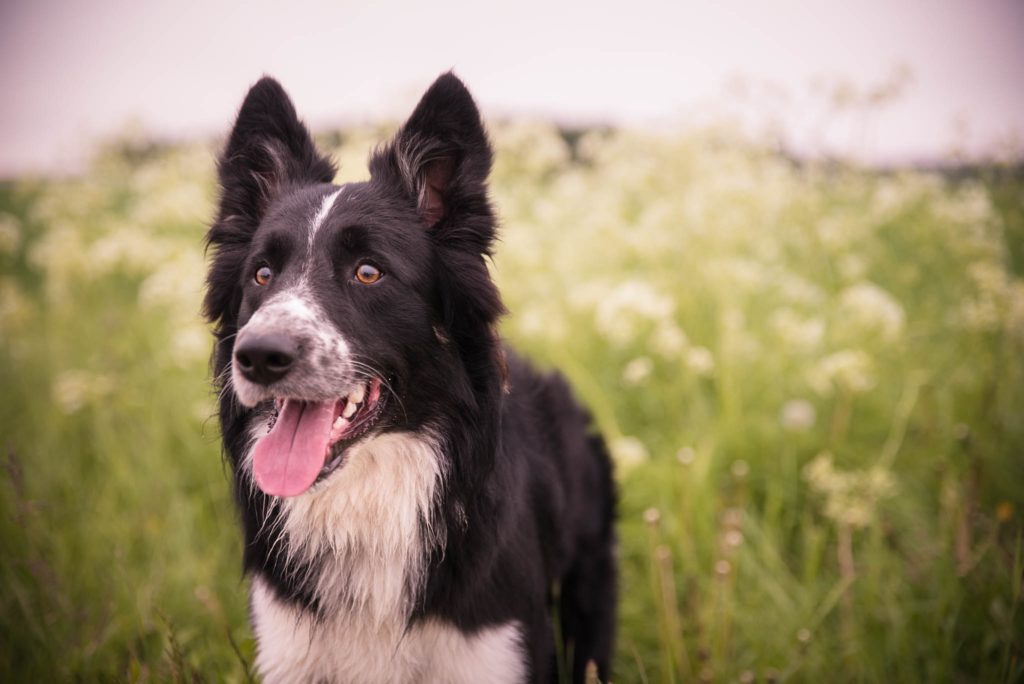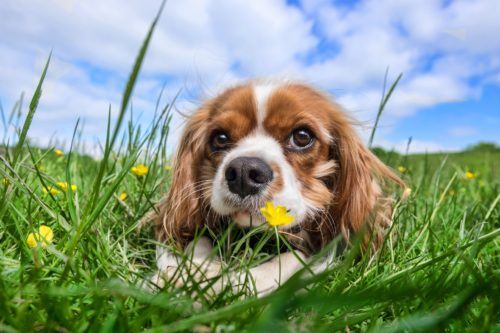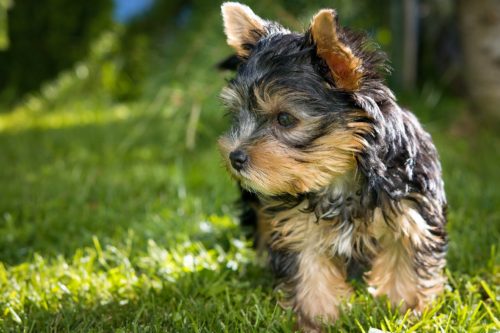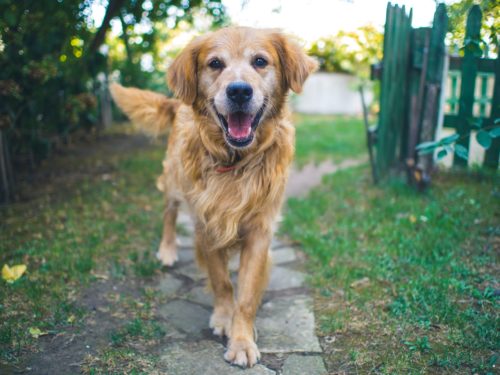When you think of dog poop, you probably think of bringing bags along on your walks, a stinky mess in your backyard, or an unpleasant surprise on the bottom of your shoe. But in reality, dog poop actually serves as a great signal of your dog’s health! Pet owners know the importance of analyzing their dog’s poop for signs of a problem and if it isn’t the correct consistency, color, or smell, they know something is up.
Unhealthy dog poop may be red, orange, white, or green. So what should you do if your dog’s poop is green? You may need to switch up your dog’s diet or take him to the vet to get checked out. But first, it’s important to understand what healthy poop looks like so you can compare. Additionally, understanding what to do if your dog’s poop is green. Lastly, knowing some other colors of poop, just so you have a comprehensive understanding of dog stool color!
What Does Healthy Poop Look Like?
Just like humans, healthy dog poop should be brown, log-shaped, and have a relatively smelly odor. You can use consistency, color, contents, size, and shape to determine whether or not your dog’s poop is healthy. Healthy dog poop is as follows:
- Shape – Most dog poop should be log-shaped and come out in large pieces. If your dog’s poop is runny, he may have diarrhea (which will be examined later, including reasons for diarrhea and what to do). If it is small circles, your dog might need more water as this is a sign of dehydration.
- Smell – There’s no such thing as a dog whose poop doesn’t stink, but this is a good thing! Your dog’s poop should be stinky (this is the smell of a healthy digestion), but not too stinky. Also, if it doesn’t smell at all you might have an underlying problem, as well.
- Color – Healthy dog poop is a rich, chocolate brown. If you feed your dog food with any added colors, such as a kibble with colored swirls, these might show up in his poop.
- Amount – The amount your dog poops should correspond with how much he eats. Too much poop might mean that he has too much fiber in his diet, while not enough poop might be a sign that he’s constipated.
- Contents – Your dog’s poop should be made up of what he last ate. If you notice mucus, parasites, or anything else abnormal in your dog poop contents, talk to your vet immediately. This is likely a sign of an underlying health issue
- Consistency – It should be easy to pick up your dog’s poop, but it should still be a little squishy (like Play-Do) in your hand.
You can use most of your senses to determine if your dog’s poop is healthy or not. Smell it, feel it, see it – just don’t taste it!
Why is My Dog’s Poop Green?
This is a common question for dog owners and for good reason! The reasons why your dog’s poop is green can range from just a simple diet change to something much more disastrous. In addition to personality changes, your dog’s poop is a sure way to tell if something is off. If you’re used to seeing nice, brown, healthy poops in your backyard and then all of a sudden come across some runny green goo, you know something is up. Let’s examine some of the most popular reasons why your dog’s poop might be green.
Eating Grass
Believe it or not, dogs actually eat grass willingly because it helps with their digestion and dates back to their wolf-roots. It can also calm their stomach if it’s upset because it serves as a natural digestive and veggie. Most veterinarians actually consider eating small amounts of grass common and grass is the most commonly eaten plant when animals have access to a variety of plants. Some pet stores even sell pet grass as a snack for your dog or cat!
If your dog eats too much grass, though, try switching him to a high-fiber food. Grass serves as a natural source of fiber, so if you are able to supplement this fiber with food instead of grass, your dog might stop eating as much. In addition, if you notice that your dog eats excessive amounts of grass or anything else that isn’t food, he might have a rare disease called Pica. Pica happens in both cats and dogs and presents itself as a dog eating things that aren’t food. If you notice your dog eating lots of grass, and his poop is consistently green, call your vet to discuss the possibility of pica.
Diet Changes
If you notice that your dog has green, runny poo, it may be because of any recent diet changes. While most dogs are pretty adaptable when it comes to their meals, it’s important not to change your dog’s diet too drastically too soon because this may cause diarrhea. If you are changing your dog’s food, follow these steps to help his tummy adjust:
- Start by mixing just a small amount of food with his current food, such as 80% old food, 20% new.
- If this goes smoothly, gradually increase the amount of new food in the serving. You can jump up to 70% old food, 30% new food, then half and half, then eventually you can feed him all new food.
- If you notice that your dog is vomiting or has runny, green poop, switch back to the old food and start over. Patience is key when switching over to a new food and your dog will thank you for thinking of his stomachs happiness.
Luckily, if your dog’s green poop is caused by a diet change, his body will likely correct itself or you know what not to feed your dog. This is generally a short-term issue and shouldn’t be a reason for concern.
Giardia
Giardia in dogs is a relatively common parasite that can cause green poop. It is most commonly seen in dogs that have been around lots of other animals and the parasite can be passed between animals and humans. It infects dogs when they eat a giardia cyst, found in the waste of another animal affected or in contaminated water sources. The cyst then ruptures inside the dog and the parasite is free to reproduce.
If you think your dog’s green poop is a sign of giardia, contact your vet immediately. If left untreated, a giardia infection can cause serious gastrointestinal inflammation, diarrhea (either isolated or chronic), malabsorption and other digestive issues, and weight loss. Not all vets are able to test for giardia, so make sure you schedule an appointment with one who can. This will help you treat your pup and make sure he is happy and healthy!
Too Fatty of a Diet
If your dog’s poop is a greenish-brown and looks greasy, it may be a sign of too much fat in his diet. This fat, either animal or processed, is not digested the same as proteins, which means it is often discarded as waste. If this is the case, you may want to speak to your vet about diet changes. In addition to being unhealthy, a too fatty diet can lead to pancreatitis or an inflammation of the pancreas. Pancreatitis in dogs can range from mild to life-threatening and symptoms include vomiting, lethargy, abdominal pain, and diarrhea.
Your vet may perform a blood test called PLI to test for pancreatitis. This test shows the levels of the two main pancreatic enzymes, lipase and amylase. Pancreatic inflammation should be addressed as soon as possible, and green poop may be one of the signs of a fatty diet which can result in this disease.
Ingested Rat Poison or Other Harmful Chemical
In addition to eating too much grass, your dog’s poop may be green because he ingested poison or another harmful chemical. Pet owners should specifically keep their eyes out for rat poison because it is common in urban areas and can be very harmful to dogs. If you believe your pet has ingested rat poison, take him to the vet immediately. While he may seem fine at first, the rat bait can take a toll on your dog’s health over time because today’s rat poisons work to stop the rat’s blood from clotting. Similarly, this can take place in your dog’s body, as well. Once your dog’s blood stops clotting, he will start to bruise easily and internal bleeding may occur. If this begins, without clotting factor, your dog may die. Luckily, immediate vet care can help prevent this and often times, the cure is simple and effective.
Slimy Green and Brown Poop
There are actually many different variations of “green poop” and one of them is poop that has a type of mucus layer or slime. We should also preface this by saying that some mucus in your dog’s poop is completely normal, and actually healthy. This small amount of slime is produced by the intestines and serves as a lubricant to keep everything moving.
But too much mucus in your dog’s poop might be a sign of a virus such as canine parvovirus. Parvo symptoms vary depending on which strain a dog contracts, as there is both intestinal or cardiac. According to the ASPCA, “the disease has an incubation period of roughly four to six days, and an infected dog may begin to shed the virus in its stool before the first symptoms appear.” Parvo is transmitted through contact with other dogs that have the virus and ingesting their feces.
Other Colors of Dog Poop to Look Out For
Who knew that dog poop could come in every color of the rainbow? In addition to green poop, there are many other colors of dog poop that may or may not be healthy. Some include:
- White poop, which is likely caused by too much calcium in your dog’s diet, often because he is fed raw food.
- Black poop, or tar-like poop, which may be a sign of a gastrointestinal or stomach ulcer.
- Red or bloody poop, which may be a sign of bleeding in your dog’s gastrointestinal tract.
- Yellow dog poop, which, when it contains yellow mucus, usually indicates a food intolerance. Examine the ingredients of your dog’s food to make sure he isn’t intolerant.
- White specks in your dog’s poop, which could be worms. Most worms in dog’s poop are treatable, contact your vet for more detailed care.
Conclusion
Analyzing your dog’s poop may sound gross, but it’s a good way to gauge his overall health and it’s important to know what to do if your dog’s poop is green. Below is a quick look at what to do:
- Know what is causing your dog’s poop to be green. It’s likely from eating too much grass.
- Other causes could be because of diet changes, ingesting poison, a disease like giardia, too fatty of a diet, or because of a virus-like parvo.
- Healthy poop can be identified by its color (brown), shape (like a log), a consistent texture, and a consistent smell.
- If you notice that your dog’ poop is green because he has been eating too much grass, try giving him more fiber in his diet. Your dog might be craving the nutritional fiber in grass.
- If you consistently notice that your dog’s poop is green, take him to the vet for a more thorough examination.
Poop is more than just something that you step on with your shoes and track through the office. It’s color, consistency, amount, and contents can all be signs of a healthy dog or a problem to identify. One of these abnormal colors, green, is likely caused by your dog eating too much grass or from an underlying condition that includes diarrhea as a symptom.
Sources:
- Brown, Jackie. “Green Dog Poop – Is It Always a Cause for Concern?” Dogster, 25 Jan. 2018, Accessed 20 Dec. 2017. www.dogster.com/dog-health-care/green-dog-poop-is-it-a-cause-for-concern.
- Naviglia, Nocole. What Does Dog Poop Color Mean? CanineJournal, 7 June 2017, Accessed 20 Dec. 2017. www.caninejournal.com/dog-poop-color/.
- “Pooping Green in Dogs – Definition, Cause, Solution, Prevention, Cost.” WagWalking, 23 July 2017, Accessed 20 Dec. 2017. www.wagwalking.com/symptom/why-is-my-dog-pooping-green.
- Fischer, Fern. “Green Diarrhea in Dogs | Cuteness.” Cuteness, 9 Feb. 2017, Accessed 20 Dec. 2017. www.cuteness.com/article/green-diarrhea-dogs.
- “Canine Medical Problems Indicated with Dog Feces.” VetInfo, Accessed 20 Dec. 2017. www.vetinfo.com/canine-medical-problems-dog-feces.html.







